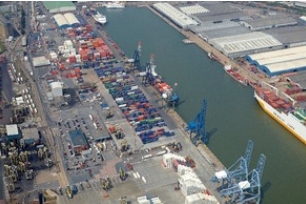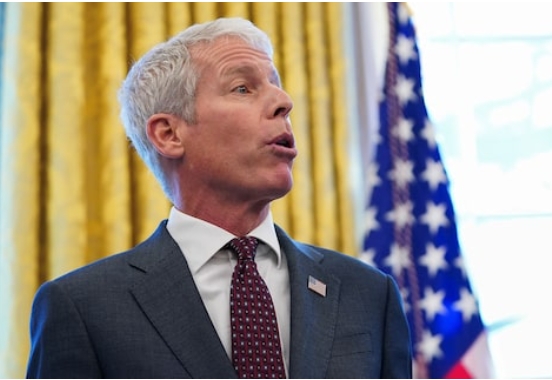We find that after the launch of the Chinese Belt and Road Initiative in 2013, the countries of the world were divided into countries linked to China economically through the Chinese Digital Silk Road, by (providing with Chinese infrastructure instead of adopting Western technology controlled by the United States of America and its international companies). Currently, China’s ambition revolves around a “new digital Silk Road” that connects the world together by land, sea and digital routes, and allows China to spread its political and economic style globally. Hence, new changes have occurred as a result of the Chinese-American competition in the field of digital infrastructure, to the point that Chinese President (Xi Jinping) has now announced $60 billion to train (African scientists to support technological growth linked to China). The Chinese-American competition in the field of artificial intelligence has divided the world into two parts after the spread of the Corona pandemic or (Covid-19). The epidemic came as an early test to reveal the ability of each country to mobilize artificial intelligence on a large scale in response to the threat to national security, which China has excelled in globally and in the United States of America itself.
The Chinese ambition also increased after the spread of the Corona pandemic to excel in the field of artificial intelligence globally and to build a new Chinese digital Silk Road and spread it in all countries associated with the Chinese Belt and Road Initiative, which was clearly reflected in all the speeches of the Chinese President (Xi Jinping), through focusing Comrade “Xi” has a transparent strategy, based on: using artificial intelligence in a dual manner, in order to control citizens internally in China, then the Chinese digital transformation globally so that it can be the first power in the world at the same time, and spreading its digital technology across the countries through which the Belt Initiative passes. And the Chinese road globally. China’s agenda, according to the Fourteenth Five-Year Plan in October 2020, aims to produce global technical champions and experts in the field of artificial intelligence by 2025, and for China to develop its technologies in the field of data mining and new microprocessors. Hence, China has now become a leader in the fields of scientific research and development, and currently registers more patents than the United States itself. After the launch of the Chinese Silk Road, the Chinese government succeeded in spreading its technological infrastructure along geopolitical lines. China established a “large firewall” that allowed the ruling Communist Party to control the entire Internet, for mainly political reasons to prevent terrorist recruitment of Chinese citizens, and some countries close to China, like Pakistan, has closed parts of the Internet in the country to people accused of being “terrorists” .
Today, China has become a strong technological competitor to the United States of America. It is organized and equipped with resources, in addition to the Chinese determination to win this technological competition and reshape the global order again to serve its interests and the interests of developing countries or the Global South, as China calls it. Therefore, artificial intelligence and other emerging technologies are pivotal in China’s efforts to expand its global influence and surpass the economic and military power of the United States of America. In order to secure local stability on the home front, China is working to implement a systematic, centrally directed plan to extract information about artificial intelligence from abroad through espionage or tracking, surveillance, and monitoring techniques, while employing talent, transferring technology, and making the necessary investments for this. The result now, after the increase in the American trade war that it is waging against China, and its fight against the “Chinese company Huawei” on the grounds of its relationship with the Chinese army or the Chinese Communist Party, has led to the fragmentation of the digital network now into several geopolitical entities between developing and African countries that use Chinese technology and Western countries that use other advanced technology.
After China announced the strategy of the global Belt and Road Initiative, (the Chinese company Huawei), as well as the four largest Chinese technology companies, namely: (Baidu, Alibaba, Tencent, Xiaomi) played in supporting the Chinese global project for the digital Belt and Road, so that China becomes the world’s number one digital power by 2049. China’s control over artificial intelligence technology and its dissemination through the Belt and Road Digital Initiative is not just an economic issue, but China is now using it with the aim of reviving the ancient Silk Road and linking China digitally with the whole world, which is the same as indicated by the most important book on artificial intelligence technology and China’s digital Silk Road, which titled: “Is Artificial Intelligence Killing Democracy?”, this book concluded that “advanced technology linked to China is capable of spreading Chinese political ideas in the face of Western and European democracy”.
In July 2023, the Research Center of the Center for Security and Emerging Technology in the United States of America warned of China’s exclusive ownership of important technologies related to artificial intelligence, and its refusal to share them with its competitors, which affects the industry around the world. There were also published accusations against researchers from the American company Microsoft, on Thursday, September 7, 2023, that they had discovered what they believe to be a network of fake accounts on social media controlled by China, through which China seeks to influence American voters, using advanced artificial intelligence technology. To which the spokesman for the Chinese Embassy in Washington responded, saying that the accusations directed at his country that it is using artificial intelligence to create fake and fictitious accounts on social media to influence the course of the American elections are pure lies and slander and “full of bias and malicious speculation”, and that China calls on to the safe use of artificial intelligence.
In order to achieve the dream of surpassing China in the field of artificial intelligence, the United States of America and the European Union launched the (Technology and Trade Council) project, which was recently launched as a joint American-European project, which reflects the call of the (US National Security Committee on Artificial Intelligence) for strategic dialogue between the United States. And the European Union, on emerging technologies), which is considered a new American-European mechanism to confront China technologically. On July 13, 2021, the US National Security Committee on Artificial Intelligence hosted the Global Emerging Technology Summit, which presented the most important comparative advantages enjoyed by the United States of America and its network of allies in the field of artificial intelligence technologies in various parts of the world, in order to develop a plan. An American court is determined to prevail over China’s communist values in the face of American and Western democracies, through coordination with a wide network of alliances between democratic countries, rooted in common values, respect for the rule of law, and recognition of basic human rights, according to the plan envisioned by America during the conference hosted by (the relevant US National Security Committee with artificial intelligence) in 2021.
Based on our previous understanding of this clear technological competition between the United States of America and China digitally, and China’s attempt to make its Belt and Road project a success digitally, by connecting all countries digitally and technologically to China using advanced artificial intelligence techniques, which China considers to be part of the active efforts made by the Chinese state to enhance (the vision of the Community with a Shared Future for Mankind, the Global Development Initiative, the Global Security Initiative, and the Global Civilization Initiative) were launched by Chinese President “Xi Jinping”. Given that artificial intelligence represents a new field for human development, it offers great opportunities, and at the same time it is accompanied by risks and challenges that are difficult to predict and require a global response, so the competition around it has become digitally intense between the United States of America and its allies in the face of China and the Chinese Belt and Road Initiative countries.







